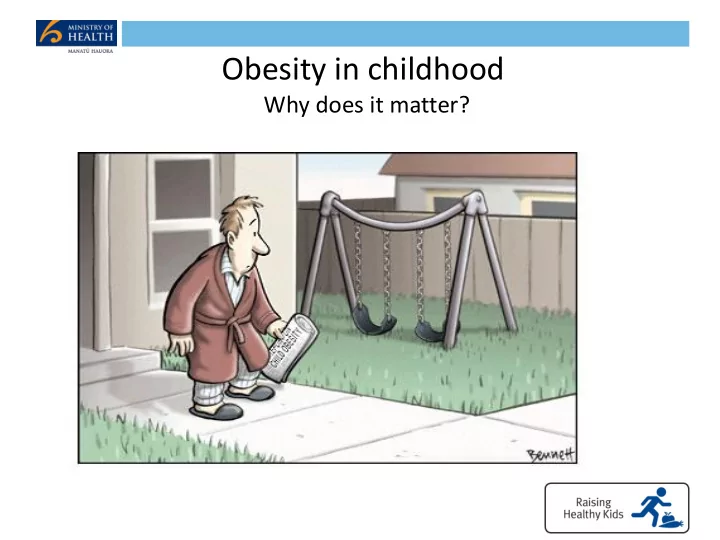

Obesity in childhood Why does it matter?
Child obesity has significant health risks
Raised BMI by Dep Index (B4SC data 2009-13)
Raised BMI by Ethnicity (B4SC data 2009-13)
Child obesity (>98 th centile) at 4 years January 2016 16% 14% 12% Percentage of Children 10% 8% 6% 4% 2% 0%
A bio-psycho-social approach to obesity Biology • Individual genetic factors play a small but important role in obesity. • The rapid increase in obesity in the last few decades is likely to be due to an epigenetic change caused by our environment and behaviour. • Pre conception and gestational environments are also important • The “Microbiome” influences hormones associated with appetite and obesity Lifestyle and social influences • An individuals’ diet and physical activity is the proximal cause of obesity. • However an individuals’ choices are influenced by the availability of information, and their understanding of the information they receive. • Learnt behaviour and social patterns of interaction also play a significant, but poorly understood role. Environmental influences • The choices an individual makes are always constrained by their environment. • Energy dense foods are cheap, readily available and heavily marketed. • Our level of physical activity has decreased and technological, social and environmental changes have led to more sedentary lifestyles.
Achieving a healthy weight Enablers • • A collaborative approach is adopted Leadership and coordination across the health sector, across central government agencies and government, food industry, within the health sector marketing and advertising, sport • Healthy environments and recreation sectors, and other Clear, consistent messages about relevant parties nutrition, physical activity and healthy weight Retail environment: promotion of healthy foods (Health Star Ratings) • Community capacity and capability Culturally relevant local level activities for Māori and Pacific communities, and low socio-economic communities • Public are empowered and supported By developing individual skills for people to make healthier lifestyle choices Better information and labelling
Achieving a healthy weight Barriers • Environmental and wider societal factors , for example Health and food literacy Food composition and environment Reduced opportunity for physical activity in an increasingly urbanized and digital world • Community and social environment , for example Dependency on passive forms of transport Increased screen-based entertainment • Individual behaviours , for example Eating large portion sizes Snacking on high-kilojoule foods • Psychosocial factors , for example Parents of obese children do not identify their obese child as overweight Influence of peers, siblings and wider community
Childhood obesity plan overview • The Government announced the Childhood Obesity Plan on October 19, 2015. The package of initiatives aims to prevent and manage obesity in children and young people up to 18 years of age. • The Plan has three focus areas made up of 22 initiatives (either new or an expansion of existing initiatives) : o Targeted interventions for those who are obese, increasing over time o Increased support for those at risk of becoming obese o Broad approaches to make healthier choices easier for all New Zealanders. • The focus is on food, the environment and being active at each life stage, starting during pregnancy and early childhood. The package brings together initiatives across government agencies, the private sector, communities, schools, families and whanau. • Information can be found on the following website: http://www.health.govt.nz/
Childhood obesity health target – Raising Healthy Kids • A new health target has been implemented from 1 July 2016: o By December 2017, 95% of obese children identified in the Before School Check (B4SC) programme will be referred to a health professional for clinical assessment and family based nutrition, activity and lifestyle interventions . • The target was selected as the B4SC focuses on early intervention to ensure positive, sustained effects on health. • The target defines obesity as a BMI above the 98 th centile on the NZ-WHO growth chart.
Obese children referred to services January 2016 60% 50% Percentage of Children 40% 30% 20% 10% 0%
B4School check performance by DHB All Checks Performance against Targets High Dep Checks 70% Target 60% 50% 40% 30% 20% 10% 0%
NZ-WHO growth charts • In 2008, new Growth charts based on growth standards developed by the World Health Organization in 2006 were introduced into the Well child Tamariki Ora programme. • The charts are expected to form the basis of a national growth chart for children and adolescents • The new charts used the growth patterns of babies that had only been breastfed, and were based on optimal growth, rather than on average growth. • A new WHO growth reference for adolescents has also been developed to bridge the gap between 5 and 19 years. The BMI +1SD at 19 closely matches the adult value for overweight and +2SD for obesity the adult value for obesity.
NZ-WHO growth charts
Growth charts used by GPs
Current GP referrals for obese children
GP survey – Investigations in obese children ✖ ? ✔ ✖ ✖ ✖ ✔ ✖ ? ✖ ✖ ? ✖ ? ✖
Suggestions for assessment and management of obese children
Monitor Growth Intervene here
Assess Cardio-metabolic • Pre(hypertension) • Dyslipidemia/Fatty liver • Pre-diabetes Orthopedic • Hips and knees Skin • Mechanical/hygiene effects • Acanthosis nigricans Respiratory • Asthma • Obstructive sleep apnoea Endocrine/Genetic • Short stature • Dysmorphic features • Developmental delay
Manage F ood • Nutritionally balanced diet • Sufficient calories for linear growth • Family meals • Slower eating • Avoid snacking A ctivity and sleep • Play and physical activity • Reduce screen time (esp TV) • Sleep time • Infants 12-15 • Toddlers 11-14 • Preschoolers 10-13 B ehaviour • Active Families • Behavioural strategies (? Triple P) • BeSmarter resource (Wai-kids)
Maintain Review opportunistically Address comorbidities Accept setbacks – maintain positivity Encourage family activities and sport Link with local Regional Sports trust Encourage cultural initiatives e.g. Kapa-Haka Support communities Healthy Families NZ Iron Maori Community gardens/Kai Atua
Recommend
More recommend